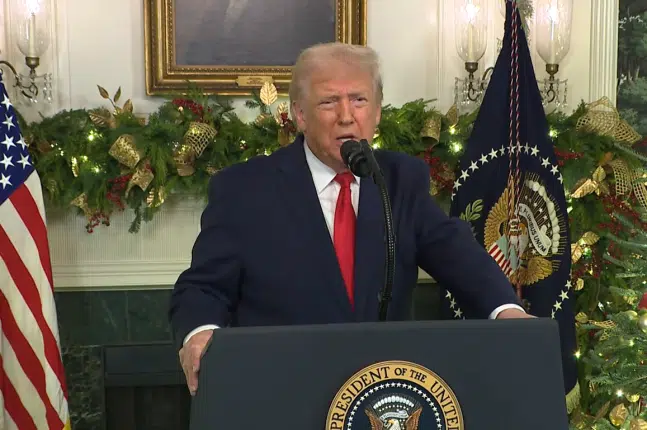
A demographic trend Americans for Limited Government has been warning about for years is materializing before our eyes this election, with a significant number of Black and Hispanic voters – especially young men – planning to abandon Democrats.
President Joe Biden’s shaky performance was already sending economically driven minorities running from the Democratic Party in polls conducted last autumn, but that trend has only accelerated since Vice President Kamala Harris replaced him as the nominee.
Now, polling shows Harris is well below where Biden was with Black and Hispanic voters four years ago, and former President Donald Trump is on track to make the largest gains with minorities of any GOP presidential candidate in 60 years.
The latest New York Times/Siena College poll shows that minority voters continue to move toward Trump, with the former president eking out sizeable portions of the Black and Hispanic vote, with particular strength among men, young people, and the working-class.
It’s always a good idea to temper expectations – no one is saying Black and Hispanic voters are completely switching parties. However, as the Times’ Nate Cohn recently pointed out, Trump may be on track to do better among minorities this fall than any GOP presidential candidate since the Civil Rights Act in 1964. That is worth exploring.
According to the Times data, Kamala Harris is still on track to win the overwhelming majority of the Black vote, with 78 percent of Black voters planning to support her while 15 percent plan to support Trump. This still places Harris – a Black woman – nine points below where Biden was with Black voters in 2020. So where is that slippage coming from?
Black Americans planning to vote for Trump are disproportionately men, younger voters, and those living in the western part of the country, according to the data. While 70 percent of Black men plan to support Harris, 20 percent plan to support Trump. Among Black women, 83 percent plan to support Harris and 12 percent plan to support Trump. It’s worth noting that in 2020 Trump earned just 12 percent of the Black vote overall.
Then there is age. Young Black voters under age 30 appear to make up a sizeable portion of those planning to desert Democrats this fall and vote for Trump. A fifth of Blacks under 30 plan to support Trump, compared to around 15 percent for older voters.
Another interesting takeaway is individuals who identify as Black mixed with another ethnicity are significantly more likely to support Trump than those who identify as Black alone. A third – 33 percent – of those with a mixed ethnicity plan to vote for Trump in November.
Another interesting takeaway is that Black voters from regions that have less of an African American presence and that never experienced slavery – such as the western part of the United States – are significantly more likely than Blacks from the south or east to support Trump. A full 34 percent of Blacks from the western United States plan to vote for Trump, while only 12 percent of eastern Blacks and 15 percent of southern Blacks plan to do so.
Among Hispanics, the Times data shows Trump is ahead even more. According to the poll, Hispanics plan to support Kamala Harris over Donald Trump by a mere 12 percentage points, 52 percent to 40 percent. Let’s recall that Biden won Latinos by 33 points, 65 percent to 32 percent in 2020. Harris is on track to underperform Biden by 13 points, and Trump is on track to gain eight points compared to 2020.
Here again, Hispanic men are much more likely to be supportive of Trump, with Trump on track to outright win Latino men by five points, 49 percent to 44 percent. Among Hispanic women there is a 15-percentage point gender gap for Harris, with 59 percent of Hispanic women planning to vote for her, but only 44 percent of Hispanic men planning to do so.
Trump is also twice as popular among Latinos under age 44 as he is among Latinos over age 65. Forty-five percent of Latinos under age 44, which constitutes Millennials and Gen Z, plan to support Trump, compared to only 22 percent of Latinos over 65. Trump earns 42 percent of the Latino vote for voters 45 to 64.
Here once again, Hispanics who identify as a mixed ethnicity – Hispanic plus something else – are significantly more likely to support Trump. In fact, Hispanics who say they are mixed plan to support Trump outright, 47 percent to 45 percent. Hispanics who identify as Hispanic alone plan to support Harris 54 percent to 38 percent.
Education also plays a factor, with non-college educated Hispanics planning to support Trump by six points more than those with a college education, 42 percent to 36 percent.
Hispanics in the southern United States – which includes the densely populated swing states of Florida and Texas – plan to support Trump outright over Biden by four points, 48 percent to 44 percent. Hispanics in the west – think Arizona and Nevada as far as swing states – plan to support Harris by the widest margin, 26 points.
Among Hispanics who say they are neither Republican nor Democrat, Trump holds an eight-point advantage over Harris, indicating that while some Hispanics may be shy of the GOP label, they would prefer to vote for Trump.
One issue that has been brought up by critics is question of whether lower propensity voters – such as Black and Hispanic men – will actually turn out to vote for Trump in November.
The honest answer is we don’t know, but that doesn’t change the core issue for Democrats. While it would be a “best case” scenario for conservatives if these voters do end up supporting Trump in November by greater margins, there is a much more nuanced reality.
Even if a sizeable share of Black and Hispanic men choose not to vote at all, the fact that around a fifth of Black men and nearly half of Hispanic men are deeply unsatisfied with Democrats and Kamala Harris should be worrying to the party. Young minority men are essentially protesting the system and by indicating their willingness to vote for Trump – even if a sizeable share of them sit out the election – they are signaling their rejection of the Democrat agenda.
Manzanita Miller is the senior political analyst at Americans for Limited Government Foundation.






